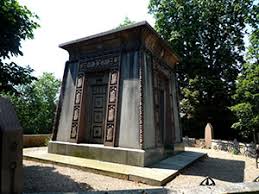
As a Residents Association, we are unusual (but not unique – see postscript) in having a Mausoleum within our foot print. St Margaret’s best kept secret, Kilmorey Mausoleum, was built in 1854 and is a grade II* listed building.
The Kilmorey Mausoleum (pronounced Kil-murry), was designed by Henry Edward Kendall Jr. (1805–85) and built, at a cost of £30,000, in pink and grey granite with a bronze door in the style of an ancient Egyptian monument and has been described by Historic England as a “fine example of an Egyptian-style mausoleum, with an unusually good interior”.
Francis Jack Needham, known by some as “Black Jack” due to his dark complexion, succeeded his father as the Second Earl in 1832. He lived in five different houses in Twickenham, including Gordon House, St Margaret’s House and, further towards Hampton, at Orleans House, Cross Deep and Radnor House. He commissioned the mausoleum which was originally situated in Brompton Cemetery for his mistress, Priscilla Anne Hoste (1823-54). Priscilla became ill in 1851 and as it was known that she had a terminal disease of the heart, Kilmorey began making preparations for her burial and in 1853 wrote to Brompton Cemetery regarding a select plot. It took over a year for details to be settled and approved by the Home Secretary and cost Kilmorey £1,030.16s.9d.
Priscilla died in 1854 following a terminal heart condition which she developed in 1851. Their relationship developed from his friendship with her parents Captain William Hoste and Lady Harriet Walpole. When Captain Hoste died, the Earl became a guardian of the children and in the early 1840s he eloped with Priscilla. A search was mounted but it appeared that they had fled abroad, without trace. After their return to England, their son, Charles, was born at Cross Deep House on 19 July 1844.
In 1862 when Kilmorey moved to Woburn Park, Chertsey, he moved the mausoleum with him at a cost of £700. Just six years later Kilmorey moved again, this time to Gordon house, moving the mausoleum for the last time. At Gordon House, the Earl made a tunnel to the mausoleum and it is said that, dressed in white, and laid in his coffin, he would get his servants to push the coffin on a trolley down the tunnel for practise. The family motto of the Needhams is nunc aut numquam (now or never).
When Kilmorey himself died in June 1880, aged 92, he was buried beside her in the mausoleum underneath a bas-relief in white marble showing the dying Priscilla on a couch surrounded by her lover and ten-year-old son Charles (b.1844). The bas-relief was carved in Rome by portrait sculptor Lawrence Macdonald (1799–1878).
In early 2016 Richmond Council completed a £90,000 restoration programme. The cast iron railings which were damaged during the great storm of 1987 were restored, along with repairs to the boundary walls. The works were carried out by Triton Building Restoration under the supervision of Kaner Olette architects. Historic England (HE) hwere closely involved and the building which was once on the (HE) at risk register is now conserved, and has been taken off the risk register. The project is a regional finalist of the Civic Trust Awards (Greater London) – and a plaque has been installed within the gardens.
During the restoration works a herringbone path to the front of the mausoleum was found and restored. A lock plate presumably from the mausoleum gates was also found buried in the gravel and this will be displayed at the celebration event.
The Mausoleum is open to the public, generally on a Sunday, a few times during the year. Opening dates are sometimes posted on our Twitter feed or more reliably can be found on the web site of the Richmond Environmental Trust:
http://www.environmenttrust.co.uk/kilmorey-mausoleum
PS Though smaller and not as impressive as Kilmorey’s Mausoleum, there is a mini version to be found nearby in Hanwell and the two have some intriguing similarities. Read more about it here:
https://www.environmenttrust.org/blog/hanwells-mini-kilmorey-mausoleum
PPS We are grateful to the Environment Trust for permission to include the above link here.
